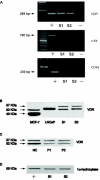Human male gamete endocrinology: 1alpha, 25-dihydroxyvitamin D3 (1,25(OH)2D3) regulates different aspects of human sperm biology and metabolism
- PMID: 19948036
- PMCID: PMC2794269
- DOI: 10.1186/1477-7827-7-140
Human male gamete endocrinology: 1alpha, 25-dihydroxyvitamin D3 (1,25(OH)2D3) regulates different aspects of human sperm biology and metabolism
Abstract
Background: A wider biological role of 1alpha,25-Dihydroxyvitamin D3 (1,25(OH)2D3), the active metabolite of vitamin D3, in tissues not primarily related to mineral metabolism was suggested. Recently, we evidenced the ultrastructural localization the 1,25(OH)2D3 receptor in the human sperm. However, the 1,25(OH)2D3 action in human male reproduction has not yet been clarified.
Methods and results: By RT-PCR, Western blot and Immunofluorescence techniques, we demonstrated that human sperm expresses the 1,25(OH)2D3 receptor (VDR). Besides, 25(OH)D3-1 alpha-hydroxylase, evidenced by Western blot analysis, indicated that in sperm 1,25(OH)2D3 is locally produced, highlighting the potential for autocrine-paracrine responses. 1,25(OH)2D3 through VDR, increased intracellular Ca2+ levels, motility and acrosin activity revealing an unexpected significance of this hormone in the acquisition of fertilizing ability. In sperm, 1,25(OH)2D3 through VDR, reduces triglycerides content concomitantly to the increase of lipase activity. Rapid responses stimulated by 1,25(OH)2D3 have been observed on Akt, MAPK and GSK3 implying that this secosteroid is involved in different sperm signalling pathways.
Conclusion: Our data extended the role of 1,25(OH)2D3 beyond its conventional physiological actions, paving the way for novel therapeutic opportunities in the treatment of the male reproduction disorders.
Figures





Similar articles
-
Temporal changes in tissue 1α,25-dihydroxyvitamin D3, vitamin D receptor target genes, and calcium and PTH levels after 1,25(OH)2D3 treatment in mice.Am J Physiol Endocrinol Metab. 2013 May 1;304(9):E977-89. doi: 10.1152/ajpendo.00489.2012. Epub 2013 Mar 12. Am J Physiol Endocrinol Metab. 2013. PMID: 23482451
-
Altered pharmacokinetics of 1alpha,25-dihydroxyvitamin D3 and 25-hydroxyvitamin D3 in the blood and tissues of the 25-hydroxyvitamin D-24-hydroxylase (Cyp24a1) null mouse.Endocrinology. 2005 Feb;146(2):825-34. doi: 10.1210/en.2004-1116. Epub 2004 Oct 21. Endocrinology. 2005. PMID: 15498883
-
Selection of High-Quality Spermatozoa May Be Promoted by Activated Vitamin D in the Woman.J Clin Endocrinol Metab. 2017 Mar 1;102(3):950-961. doi: 10.1210/jc.2016-3008. J Clin Endocrinol Metab. 2017. PMID: 27977320
-
The vitamin D hormone and its nuclear receptor: molecular actions and disease states.J Endocrinol. 1997 Sep;154 Suppl:S57-73. J Endocrinol. 1997. PMID: 9379138 Review.
-
Genomic mechanisms involved in the pleiotropic actions of 1,25-dihydroxyvitamin D3.Biochem J. 1996 Jun 1;316 ( Pt 2)(Pt 2):361-71. doi: 10.1042/bj3160361. Biochem J. 1996. PMID: 8687373 Free PMC article. Review.
Cited by
-
Effects of Vitamin D on Apoptosis and Quality of Sperm in Asthenozoospermia.JBRA Assist Reprod. 2020 Jul 14;24(3):316-323. doi: 10.5935/1518-0557.20200009. JBRA Assist Reprod. 2020. PMID: 32511900 Free PMC article.
-
Effects of vitamin D supplementation in extender on sperm kinematics and apoptosis following the freeze-thaw process in normozoospermic and asthenozoospermic Holstein bulls.Basic Clin Androl. 2021 Aug 5;31(1):20. doi: 10.1186/s12610-021-00137-5. Basic Clin Androl. 2021. PMID: 34348640 Free PMC article.
-
Cyclic AMP and glycogen synthase kinase 3 form a regulatory loop in spermatozoa.J Cell Physiol. 2018 Sep;233(9):7239-7252. doi: 10.1002/jcp.26557. Epub 2018 Mar 25. J Cell Physiol. 2018. PMID: 29574946 Free PMC article.
-
Can Vitamin D supplementation be used as adjunctive treatment for oligozoospermia or asthenozoospermia accompanied with Vitamin D deficiency?Asian J Androl. 2015 Jan-Feb;17(1):165-7. doi: 10.4103/1008-682X.138190. Asian J Androl. 2015. PMID: 25219916 Free PMC article. No abstract available.
-
Regulation and roles of Ca2+ stores in human sperm.Reproduction. 2015 Aug;150(2):R65-76. doi: 10.1530/REP-15-0102. Epub 2015 May 11. Reproduction. 2015. PMID: 25964382 Free PMC article. Review.
References
-
- Zehnder D, Bland R, Walker EA, Bradwell AR, Howie AJ, Hewison M, Stewart PM. Expression of 25-hydroxyvitamin D3-1alpha-hydroxylase in the human kidney. J Am Soc Nephrol. 1999;10:2465–2473. - PubMed
-
- Norman AW, Okamura WH, Hammond MW, Bishop JE, Dormanen MC, Bouillon R, Van Baelen H, Ridall AL, Daane E, Khoury R. Comparison of 6-s-cis and 6-s-trans locked analogs of 1,25(OH)2-vitamin D3 indicates that the 6-s-cis conformation is preferred for rapid nongenomic biological responses and that neither 6-s-cis nor 6-s-trans locked analogs are preferred for genomic biological responses. Mol Endocrinol. 1997;11:1518–1531. doi: 10.1210/me.11.10.1518. - DOI - PubMed
Publication types
MeSH terms
Substances
LinkOut - more resources
Full Text Sources
Other Literature Sources
Miscellaneous

